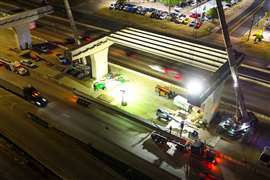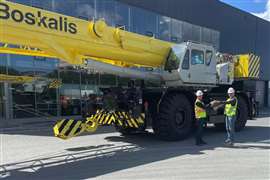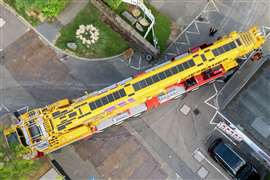Insurance answers
24 April 2008

Reducing liability costs is an ongoing priority for equipment owners who have watched their premiums rise, and rise, and rise. So how can a company contain its insurance costs? Are there ways to lower your premiums? ACT staged a virtual roundtable with executives of three industry-specific insurance firms to share their expertise and answer these questions.
Roundtable participants include Megan Rose, vice president of crane programs for JC Stevens Inc; Randy Proos, CIC, director of construction services for USI Inc and Jeff McGeary, president of Allied Insurance Brokers Crane Division.
What measures can crane and transport companies take to reduce their insurance costs?
Proos: Without question, proper classification of the firm's operations plays a huge role in the calculation of the premium. For instance, a crane rental operation may engage in a variety of activities such as crane rental with operator, bare crane rental, heavy hauling, and millwright work. All those activities carry a different rate structure and in some cases a very drastic difference in rate structure.
As an example, a crane company may not realize that the transportation of crane components such as boom sections and counterweights should be classified as hauling even though it is certainly an integral component of the crane operation. Point being, the crane classification carries a much higher rate than the hauling classification and proper segregation of those activities can certainly reduce a crane company's insurance cost.
In addition, periodic review of the scheduled values of the cranes and equipment is important. Cranes and other equipment depreciate over time and the insurance carrier will not pay an over-inflated scheduled value even if the equipment is a total loss. Crane and equipment values should be adjusted to reflect approximate market value.
For transport companies, proper classification of vehicle use, garage location, use radius, and gross vehicle weight all factor into the premium calculation and all vehicle assets should be reviewed individually with your agent or broker to find potential premium savings. Other considerations include liability and physical damage deductibles, and dropping uninsured motorist coverage for all commercial vehicles on the schedule.
McGeary: We can give companies some recommendations - one is verifiable crane inspections and well trained crane operators. Not only does this prove you have a quality operation, it proves to prospective insurance companies that you are focused on safety and quality. While crane accidents are infrequent, unfortunately, when they do happen, they tend to be severe because these are big, dangerous machines.
The second thing is to have a properly worded rental contract. Some companies feel this unnecessary, but it's an incredibly important document to use to help defend your company in the event of a lawsuit. I recommend the SC&RA rental contract.
A common claim that we get involved with is rigging responsibility. One of the common things many people are not familiar with is that you are not responsible for rigging if you don't do it. This should be in the rental contract. A hold harmless clause is extraordinarily important as well.
Rose: When we come up with our rates, there are a number of factors we look at. The best thing crane companies can do is to establish a minimum age requirement and a minimum year's experience requirement for their operators. We give credits for that.
We also want to see that the company has a signed work or job order ticket at every job site. This definitely can lower insurance costs. The work order should have a couple of components, including a hold harmless clause from the general contractor. The general contractor prepares the jobsite for the subcontractor to assure he is properly set up. Make sure the maximum weight that is being lifted is listed on the work ticket and that it is within the capacity of the machine being used. Make sure that straps and slings comply with OSHA standards.
In terms of your employees, make sure they have clean driving records. Employee drug testing can help with reducing costs.
Can establishing and maintaining a formal safety and training program help a company get better insurance rates?
Rose: Absolutely. Having a formal safety program lets the insurance carrier know that the company is trying to lessen risk - that every safety procedure possible is being done within their company.
Having a safety manual that outlines the safety policies and discusses OSHA rules and regulations is important.
Increasingly, we are seeing more companies committed to safety, mainly because of the cost of insurance. It was hitting them more in the pocketbook.
Some of the things companies can do seem like “no brainers” but, unfortunately, this is the area in which we are seeing the losses. Like slings and straps. We have had several losses where the insured did not inspect this equipment that had visible wear.
We had one claim where the operator forgot to pull in the outriggers and was driving down the street hitting parked cars. These types of claims are hard to believe. You look at this type of loss report and at first it seems funny. Luckily we don't get too many of these. While it sounds comical, it's a very serious loss with serious consequences.
Driving experience of operators is important. When you think cranes, you think of the operator. But the operator's driving record needs to be checked too. We are seeing more and more over the road claims because cranes are more mobile. These are very heavy pieces of equipment and drivers don't realize they are speeding down the road in these machines and do not realize how long it can take to slow down.
Proos: Absolutely! Today, many insurance carriers have scheduled rate credits for formalized safety programs. Additionally, insurance carriers will quote their best rates to companies who have certified operators, regular certification of their cranes and equipment, and certified drug free workplace programs. Conversely, a company that has no safety program may be subject to premium surcharges.
Crane and transport companies alike should have accurate and well documented maintenance logs for all owned equipment. Insurance company loss control representatives will want access to this information and will report their findings to your insurance company underwriter.
McGeary: Absolutely, positively. Companies need to establish regular safety meetings for their employees. Even the owner and operator need an established handbook with safety procedures outlined. This shows the carrier that the company spent the time and effort to consider and utilize safety.
SC&RA can assist with this and in helping establish safety guidelines.
Many companies think “I'm safe,” and leave it at that. But by putting it in writing, they are showing everyone what their safety criteria. Having a standardized safety program makes a company a safer company.
What should you look for when pursuing the right coverage or insurance company?
McGeary: I would say, number one, look at the financial stability of the company. If they are not correctly capitalized, they may offer the best rate but it isn't good if they aren't solvent. Look at the company's financial track record.
Also, make sure they understand the coverage you need. Make sure you have the correct definition of mobile equipment on the general liability form.
It is very important that the company understands the industry, that they provide industry specific coverage. You may get a great rate with a company not specific to the industry but you may not actually be getting the coverage you need. Having coverage from an industry specific player from agency and insurance company can benefit you tremendously, especially in the event you have to file a claim.
Look for a company that will analyze your current policies, conduct an in-depth claims review and identify claim problem areas and suggest solutions. The company should be able to review and identify potential coverage gaps, and help you get optimum pricing levels by helping you manage risks more efficiently. A good firm will offer premium reduction alternatives through deductibles and other risk transference mechanisms. Claims can be a threat to your company's long-term survival.
Rose: To me the most important thing is making sure you are getting the coverage for the operations your company is performing. When we lose business and find out who we lost to, and then we realize the company purchased coverage that doesn't apply to their operations.
Also, make sure that if you aren't getting an auto policy, that the crane is covered while driving over the road. Some policies don't cover this.
Many states require an automobile policy in the state statutes. There are certain things you want to make sure of, proper class codes.
Proos: First and foremost your insurance program should be placed with an insurance carrier that specializes in or has insurance programs for your industry. Many of the coverages need to be specifically tailored for your industry exposures. For instance, crane companies will require boom collapse and overweight coverage for their cranes and riggers' insurance for their “on-hook” exposures.
Moreover, your insurance program should include bona fide “Pre-loss” risk and contract management and “Post loss” claims and litigation management components.
From a pre-loss standpoint, your insurance carrier should be actively involved in managing the contracts that your company signs and the company contracts or work tickets that your clients sign for you. These contracts typically contain hold-harmless or indemnification language that can make or break the outcome of a claim. Your insurance carrier should understand the statutory laws of the states in which you conduct business and your contracts should be in compliance with any construction indemnification statutes.
STAY CONNECTED


Receive the information you need when you need it through our world-leading magazines, newsletters and daily briefings.
CONNECT WITH THE TEAM











